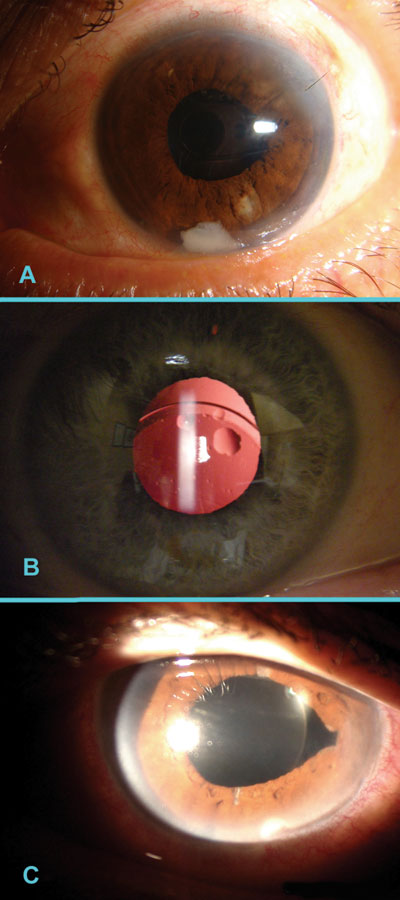Managing transient, anatomic and long-term complications of cataract surgery
Examining patients on the first postoperative day is helpful in revealing complications, so they may be resolved more quickly.
 Uday Devgan |
Modern-day cataract surgery via phacoemulsification is a safe procedure with a very low incidence of complications. The majority of patients achieve significantly better vision in a brief, painless procedure performed on an outpatient basis. While complications from cataract surgery are rare, they can happen and they can adversely affect the patient’s vision. Many of these complications are evident the day after surgery, so it is recommended that patients are examined at that time. Any issues that are detected can then be resolved in a timely manner so that proper healing and recovery occur.
Transient complications: usually indicating medical treatment
Blurred vision: The trauma of the surgery, particularly the ultrasound energy and the fluid rushing through the anterior chamber, can induce corneal edema. This presents as blurred vision until the endothelial cells are able to pump the water out of the corneal stroma. With use of high-quality viscoelastics, corneal edema is less common, but a prolonged surgery of a dense nucleus may result in focal or sometimes diffuse corneal swelling. Controlling inflammation with steroids and perhaps using a hypertonic saline solution can help hasten recovery of vision.
 Postop day 1 complications: (A) A retained cataract fragment is seen in the inferior angle; (B) The IOL is subluxated and insufficiently supported, with silicone oil droplets adherent to its surface; (C) The iris is trapped inside a leaking corneal incision. Image: Devgan U |
High IOP: The IOP should be in the physiologic range for most patients. It can be higher due to retained viscoelastic or lower due to leakage from an incision. High IOP can be treated medically, with both topical and oral agents, and monitored closely. As the viscoelastic clears from the anterior chamber, the pressure usually returns to normal. In most cases, tapping the anterior chamber to release aqueous is not recommended since it is typically only a short-term fix and it exposes the eye to an increased infection risk.
Inflammation: Surgical procedures always cause some degree of inflammation, so it is normal to note a degree of anterior chamber cells and flare the day after surgery. An excessively strong anterior chamber reaction with fibrin or a hypopyon is not normal and may represent the inflammation from toxic anterior shock syndrome or even endophthalmitis. The former requires frequent dosing of steroids to control inflammation, while the latter requires a diagnostic tap, injection of antibiotics and prompt intervention to prevent loss of vision and the eye. While the typical presentation of endophthalmitis is usually days after surgery, it can still present on postoperative day 1.
Anatomic complications: indicating surgical intervention
Retained cataract pieces: Because the cataract is broken into many pieces during phacoemulsification, it is possible for a small piece to be retained in the anterior chamber. These cataract pieces can cause a large amount of inflammation and focal trauma to the cornea. A small, wispy cortical piece may be treated medically with liberal administration of steroids and focal application of the YAG laser to break it into smaller fragments and increase the surface area to volume ratio, but larger pieces require surgical intervention. In cataract cases where there was a posterior capsule rupture and retained lens fragments in the vitreous, prompt referral to a vitreoretinal specialist for a pars plana lensectomy and vitrectomy is recommended.
Dislocated IOL: If the IOL implant is not securely placed, it can slip from its original position and become subluxated. This is more commonly seen in situations where the lens was placed into the ciliary sulcus due to a defect in the posterior capsule. While mild cases of IOL subluxation can be observed, a significant shift of the IOL away from the visual axis should be surgically addressed. In these cases, suture fixation of the IOL can help to ensure long-term stability and centration.
A leaky incision: Low IOP is a sign that there may be leakage from an incision. Performing a fluorescein dye leakage test can pinpoint the source and help determine the extent of fluid outflow. Significant leakage from an incision is an indication that a suture is likely required to close the wound and prevent further hypotony and risk of infection. The iris often acts as a plug to help seal these leaky incisions, so the presence of iris tissue trapped inside an incision is an indication of a leaky incision.
Long-term complications
While many of the potential complications from cataract surgery can be seen on postoperative day 1, others require time to develop. Retinal complications such as cystoid macular edema or retinal breaks often develop days or weeks after the surgery. Residual refractive errors can only be accurately measured once the capsular bag has contracted and the IOL is in its final position. Posterior capsule opacification, which presents weeks or months after surgery, is so common that we may not even consider it a complication of cataract surgery.
Modern-day cataract surgery is a remarkable procedure, but it still requires the expertise of an ophthalmologist both during and after surgery. The ultimate visual result for the patient depends equally on the surgical procedure and the healing in the postoperative period.

- Uday Devgan, MD, FACS, is in private practice at Devgan Eye in Los Angeles, chief of ophthalmology at Olive View UCLA Medical Center and an associate clinical professor at the UCLA School of Medicine. Dr. Devgan can be reached at 11600 Wilshire Blvd., Suite 200, Los Angeles, CA 90025; 800-337-1969; fax: 310-388-3028; e-mail: devgan@gmail.com; Web site: www.udaydevgan.com.
